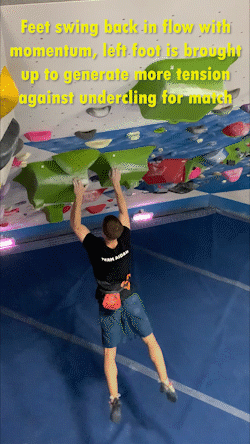Breakdown
Climber: Sebi Krzaczek 5’10”/-2
Wall angle: 45° Overhang
Holds: SoIll Wrecktangles, Kilter Winter Small Steep Crimps
RIC: Risk 4, Intensity 4, Complexity 1
This boulder revolves around testing climbers’ commitment in a minimal amount of movement. Risk is high on this boulder because of the coordination and accuracy required to stick the first dyno, in addition to the last move centering around a dynamic weight release. Intensity is equal to risk because of the shoulder and core strength required to control the momentum from the initial dyno. Complexity is low because there are few nuances or micro-adjustments to be made while climbing.
Influence/Aesthetic:
Dividing this boulder functionally and visually helps to create distinction between its sections. The distance between the large cubes keys climbers into the dynamic movement that is required to travel between them. Additionally, it divides the space on the wall into thirds, which signify the start, middle, and end of the boulder. Using smaller holds between the large cubes prevents the interim space from feeling completely empty while offering contrast in size to the cubes.
Hold Selection:
The skeleton of this boulder was formed by placing the large cubes before adding any other holds. This let me visualize the movement between them. The tops of the first two are sloped enough to be uncontrollable with one hand when moving dynamically, which led to the two crimps being used as the start holds. These crimps are incut enough to generate momentum off of but are difficult to control once the body is above them. The jug and crimps above the middle cubes are used to transition the climber above the high profile of the cubes to the second crux of the boulder.
Gear Up
Sebi begins by engaging his shoulders and sinking his hips low. This lets him create space for his legs to expand through as he pulls up, generating momentum.
He lets his legs reach maximum extension before letting go with both of his hands; grabbing both cubes at the same time prevents his body weight from pulling too far in either direction.
King of Swing
Sebi lets his legs guide his momentum; by letting them swing back to the wall and tensing his core he is able to use his feet to control his movement.
He is able to gain the juggy undercling with his feet on the start hold. However, he gets his left foot higher to engage his bicep more to pull closer to the wall for the match.
Small Box
After matching the undercling Sebi brings his right foot up, which creates a restricted position but allows him to pull his hips closer to the wall to move his right hand to the next crimp.
Keep Composure
Sebi bumps his right hand to the highest crimp. This opens his chest and hips, allowing him to raise his foot.
By pressuring his high left foot Sebi is able to release some of the tension from the left-hand undercling. This lets him release his left hand and gain the finish.
He brings his right foot up one last time to prevent his body from losing opposition from his feet during the match.
Final Thoughts
This boulder was particularly frustrating to set because I misjudged the distances between holds multiple times. This resulted in the cubes moving around quite a bit which can be difficult because they are so cumbersome. Dynamic movements with highly specific intent can be challenging to set because they require holds to be positioned at distinct angles and orientations. In this case, it lead to a lengthy setting and forerunning process because the moves had to be sampled and adjusted multiple times to be calibrated correctly. The benefit to this is that hindsight is 20/20; these mistakes can be turned into applicable improvements on routesetting processes.




